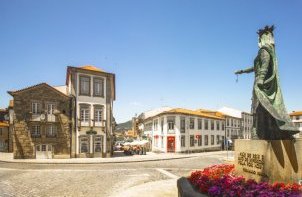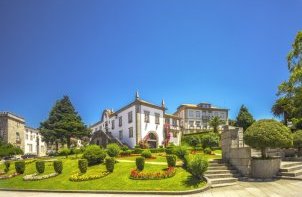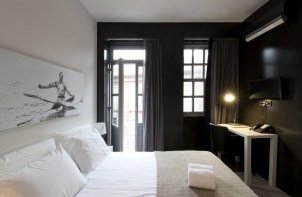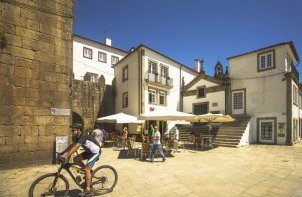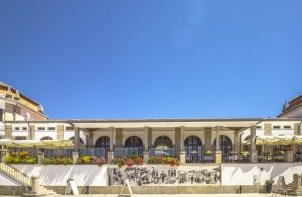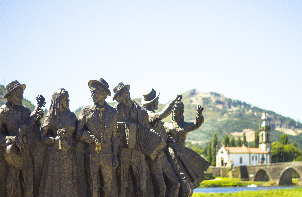The Pé
do Negro trail is a short footpath, with an approximate length of 13,7 km,
of moderate difficulty and an accumulated unevenness of 889 metres.
The
markings and signs on this trail comply with national and international
standards. The trail starts at the headquarters of the Parish Council of Bárrio
and Cepões, from where we walk towards the Parish Church of São
Miguel de Bárrio.
From its churchyard we can appreciate the valley of the Mestre
River (also known as the Labruja River), which offers us a typical
landscape of the Alto Minho region, in which the green landscape, full
of life, stands out. We soon find ourselves at the Poço do Pé do Negro (Blackfoot
well), on the Mestre River. This natural retreat, well cared for by the local
community, is perfect for a dip on hot days.
The intensity of the waters of the
Poço do Pé do Negro, in other times served a sawmill for wood, a linen
mill, and the mills for grinding various cereals. In this place there was also
a plan for the production of electric energy, a project for a
mini-hydroelectric plant, which was never concluded but of which there are
still traces.
Walking a little further, on the left side, we come across the
Varziela Bridge, a centenary crossing over the Mestre River, which
has resisted the passage of time untouched. Along the river banks, the ruins of
the mills that were built over time are clearly visible. At this point we have
to pay more attention to the markings and signs; here there is a junction with
the Portelas’ Trail which goes downhill from the Chapel of Our Lady of Guadalupe,
and the Pé do Negro Trail goes uphill on the right, following the Mestre
River.
We now follow the mixed forest until we reach Rendufe. In this
parish, we take a short detour along the road until we reach the Chapel of Santa
Luzia. Here we find the Rendufe Fishing Park, a place dedicated to
sport fishing of trout. Leaving Rendufe behind, we buckle up for the
climb and continue to the point of Picaranha, where we find the small
Chapel of Nossa Senhora da Piedade (Our Lady of Mercy).
When we reach
the highest point of the trail the landscape opens over the valley. From this
point we can see the terraces that flank the valley from a different
perspective and we can see other well-known places such as Bola de Pena,
the high place of Nossa Senhora de Fátima (Our Lady of Fatima) and the
high place of the Red Cross, on the banks of the Protected Landscape of Corno
de Bico.
We now arrive at the Chapel of São Silvestre, at 371 metres’
altitude, whose feast is held on the last Sunday of August. It is in a very
good state of conservation, with a pleasant picnic park, ideal for a
well-deserved rest. We continue down the path, enjoying the view of the valley.
We arrive at the Chapel of Nossa Senhora das Dores (Our Lady of Sorrow) and
São João de Deus (St John of God), with a small staircase leading up to
the Chapel. Here, the most important festival of the parish is held on the 1st
Sunday of June. In a small rehabilitation made to the floor of the Chapel, a
former parish priest of this parish was found buried.
We continue our way and
approach the small place of São Gens, here we find the "Penedos
dos Borralhos", a cluster of large granite boulders, rounded by rain
and wind erosion over millions of years. Here we again find agricultural land
for subsistence crops, which supply local families with vegetables, tubers, and
legumes throughout the year. In São Gens we also find the Chapel of Nossa
Senhora dos Remédios (Our Lady of Remedies) surrounded by olive trees, a
much respected and characteristic symbol of the Christian faith.
Finally, we
also find the Chapel of Nossa Senhora da Abadia, (Our Lady of the Abbey,)
a beautiful example of rural baroque. The feast is held on August 15th. A few
meters away we meet again at the Parish Council of Bárrio e Cepões, to
end this walk, in a step-by-step journey through the rural world!
Trail Name: Pé do Negro
Promoting Entity: Municipality of Ponte
de Lima
Type: Circular, Short Route
Focus: Rural Landscape
Departure/Arrival point: Parish Council of Bárrio
and Cepões
Extension: 13,7 Km
Duration: 5h00m
Skill Level: Moderate
Maximum Elevation Reached: 371 metres
Places of
interest
1. Bários’ Parish Council
2. Parish Church of São Miguel de Bárrio
3. Poço Pé do Negro (Mestre River)
4. Chapel of Santa Luzia
5. Chapel of Nª Srª da Piedade and Rural
Nucleus of Picaranha
6. Chapel of São Silvestre
7. Our Lady of Sorrows’ Chapel and Saint John of
God
8. Our Lady of Remedies Chapel and Rural Nucleus
of Sao Gens
9. Our
Lady of Abbey Chapel
Point of
departure / arrival
41°49'54.0"N
8°35'05.1"W
41.831677, -8.584752
